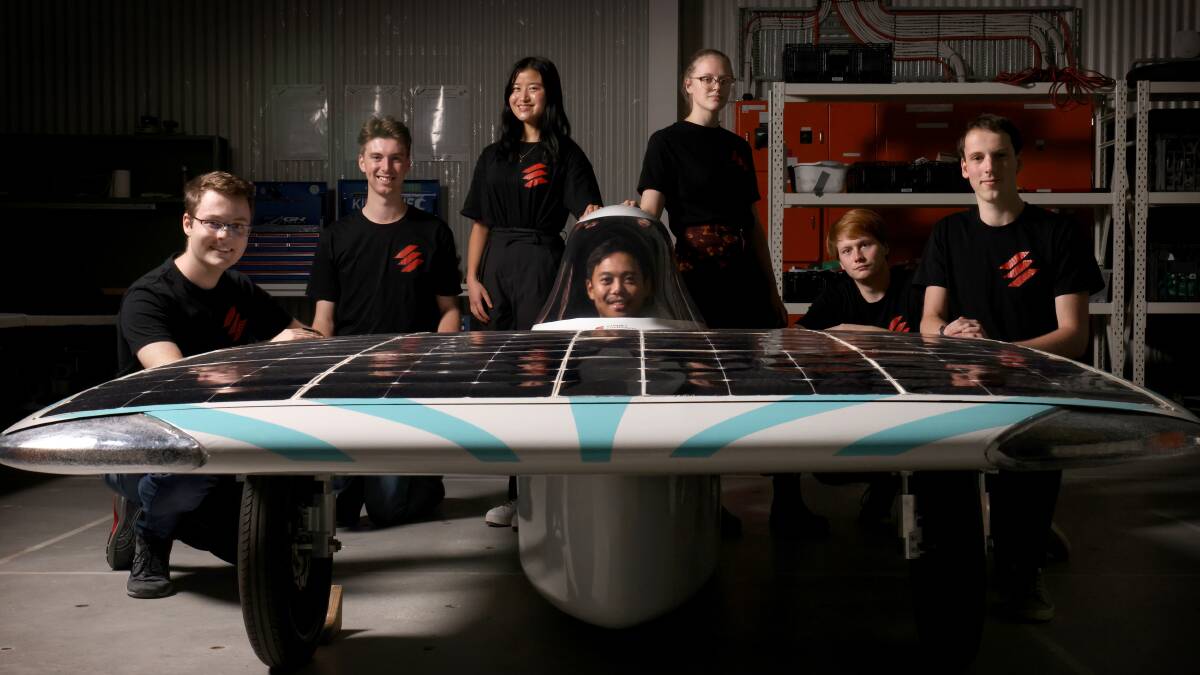
Inside a mechanic garage at the ANU, an all-student racing team is pushing the boundaries of sustainable technology.
Subscribe now for unlimited access.
$0/
(min cost $0)
or signup to continue reading
The ANU Solar Racing team is preparing a third-generation, lightweight, carbon-fibre solar car for the 3,022-kilometre World Solar Challenge from Darwin to Adelaide.
Most of the parts are built by students in a workshop on campus, with the carbon-fibre chassis the only major component built externally by a Sydney firm.
The biggest challenge for the team will be cooling the vehicle's battery. Crossing the Stuart Highway, temperatures in the vehicle will hit beyond 40 degrees.
Engineering student Thomas Scott is the electrical lead for the project and has devised a cooling system for the car known as "Solar Spirit".
"As you can imagine, driving in the desert it gets really hot - sometimes you know, 40 to 50 degrees inside the car," he said.
"We've developed a rigorous cooling system, we duct air inside the car - and then we pump it around using a series of fans and cooling ducts to make sure we have a constant airflow over the battery."
Eight drivers will be taking turns to complete the race, with an expected switchover time of 1.5 hours between each driver.
The ANU racing team have not hit the tarmac since 2019 due to the COVID pandemic but have been working on upgrading the vehicle for the 2023 event.
READ MORE:
"Solar Spirit" has three wheels with two at the front for steering and one at the back near the motor.
The engineering students say it can go as fast as they want but for the race they will need to abide by the speed limit rules.
"Because we're racing for such a long time, we need to try to make the battery last for the entire duration," Mr Scott said.
"It's probably looking around 75 kilometres an hour, that's our target."
Mechanical team member Jessica Burrows is responsible for latching the 256 solar cells onto the car.
"The latching is making sure that the top shell stays stuck to our car. For that, we're using rotary latches which connects in different series around different spots of the car," Ms Burrows said.
For Ms Burrows the biggest mechanical challenge has been the car's suspension.
"One of the biggest issues we've run into is our front suspension, we don't have as much space as you would in a regular car," she said.
"We use a forked suspension, as opposed to some of the more classical types of suspension that you'd see in a regular car."
Nurhan Raihan is one of the drivers preparing to steer "Solar Spirit" from Darwin to Adelaide.
"We go through rigorous training which involves a lot cardiovascular, heat and strength training," he said.
While training, the drivers simulate the desert conditions by wearing extra clothing.
The biggest challenge for drivers will be adjusting themselves to the heat conditions while they sit inside the small canopy.
"It's estimated that each driver will be riding for about one and a half hours but depending on whether that individual can withstand that, because it does get claustrophobic inside," he said.
We've made it a whole lot easier for you to have your say. Our new comment platform requires only one log-in to access articles and to join the discussion on The Canberra Times website. Find out how to register so you can enjoy civil, friendly and engaging discussions. See our moderation policy here.

